Mobility Infrastructures and Participation in the Extractive Industry
"Component B" of the CoRe project is interested in social impacts of existing or non-existing transport infrastructure, mobility patterns, inclusion in and exclusion from mobility and transport networks. The aim of this fieldwork in 2016 was to study current practices and changes over last decades in order to get a better understanding of life for people with and without transport infrastructure and their ideas about mobility. In the course of this fieldwork, 90 mobility questionnaires, in-depth and informal interviews were conducted with 67 informants.
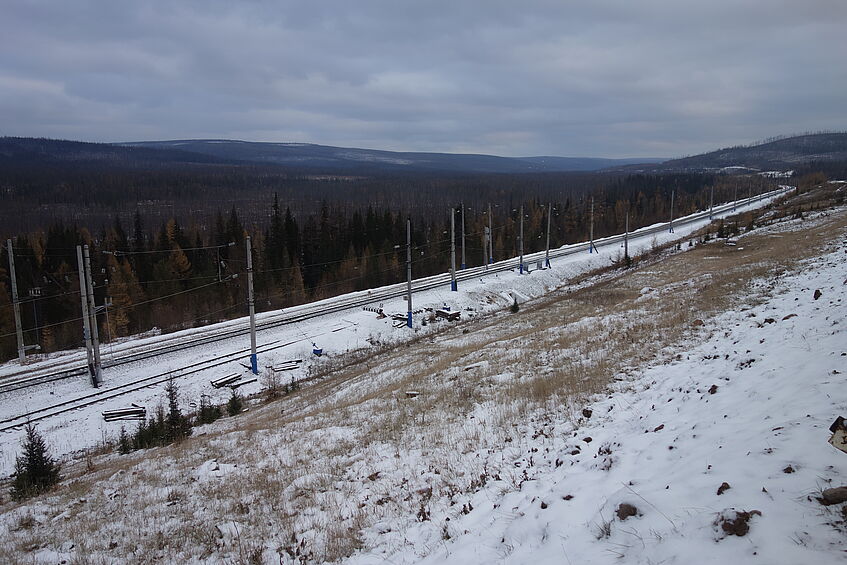
The BAM -Transportation infrastructure built to 'master the North'
During the months of September and October 2016 fieldwork for Component B, as part of the research project Cofigurations of 'remoteness' (CoRe), was conducted in four villages and small towns in the north of Irkutskaya Oblast' in Central Siberia. Those villages are located on and off the Baykal-Amur Mainline (BAM) and differ significantly in their degree of 'remoteness'. Gertraud Illmeier and Natalya Krasnoshtanova, who conducted this fieldwork, opened their work with researching Tokma, the remotest village, resumed in Verchnemarkovo, an 'oil town' still off the BAM, in order to finally reach two of the so-called 'BAM villages', Zvezdnyy and Niya, which are directly located along the Mainline.

The quality of transportation infrastructure such as roads can heavily impact on passengers.
In order to reach those specific field sites and to experience themselves the existing transportation infrastructure and -networks first hand, they had to use all possible means of transport available. This contributed to a better understanding of the impact of remote infrastructure on the lives of on-site residents. Trips by bus and plane were made to get from the capital city of Irkutsk to the Northern 'frontier', from there onwards the journey was continued by helicopter in order to reach the village deep down in the Taiga. A one day mini-bus trip including a tyre-blow out in the 'middle of nowhere' and trips on the commuters train (elektrichka) along the BAM followed.
Interestingly, taking the long-distance train as planned was not possible, despite many efforts. The fact that living in the very heart of the BAM zone does not necessarily mean facilitated access to the long-distance railway, connecting distant cities and regions, constitutes a surprising insight put forward by this fieldtrip.
Tokma

The helicopter is the only transportation connection that works all year round.
What kinds of feelings does it trigger to know that there is only one way of leaving a place and that the next possibility to do so will only be in two weeks? For the inhabitants of Tokma, a remote village in Katangskiy district of Irkutskaya Oblast', this is normality.
Tokma was the first field site visited as part of component B. It is the settlement with the highest level of remoteness of all research sites of the CoRe project. The village is home to between 60 and 70 people of Russian, indigenous and other origin, who live on hunting sable for cash income and practice subsistence fishing.
Life in all its facets is determined by the remoteness of the village and its limited transportation opportunities. In winter, a then frozen river is transformed into a winter-road (zimnik). The winter season is the only time of the year, when the village is accessible by land. The winter road connects the village to the regional centre Ust'-Kut, where the construction of the Eastern part of the BAM started in 1974. Otherwise, Tokma can only be reached or departed by helicopter.
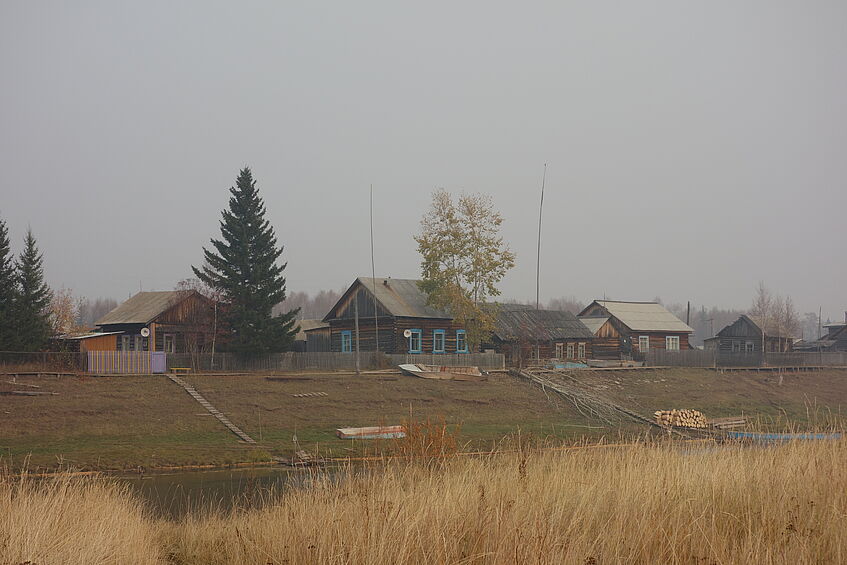
Many people have left Tokma in the recent past in order to provide their children with educational and themselves with better job perspectives.
Thus, the overall question(s) guiding this research, particularly crucial in Tokma, concerned the impact of remoteness on its inhabitants: How do people build their lives under such conditions? How does one get access to education or vocational training? How do residents fulfil their needs for health services or how do they organize administrative issues, having in mind that the municipal administration is located in a village 600 kilometres away from Tokma?
Memories associated with the 'good old days', when plane rides were provided three times per week by the then Soviet administration, are vividly shared by the village dwellers. This can exemplify that - despite of its geographical dimension - 'remoteness' is a man-made phenomenon. I.e., it can be created, intensified or mitigated through certain developmental policies.
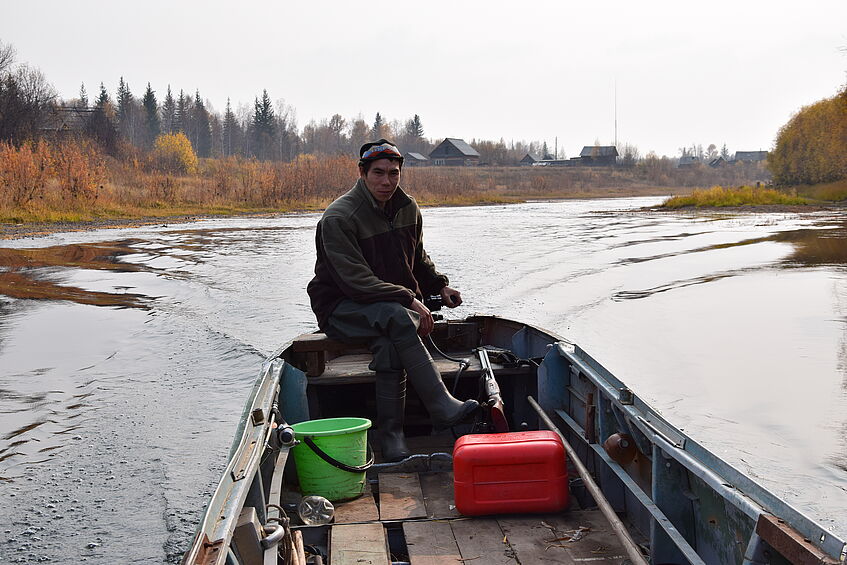
Except in winter, when the men live in the forest to hunt sable, they go fishing on a daily basis.
Today, the North of Irkutskaya Oblast' experiences an economic boom in the extractive and transportation sector to ensure exploitation and export of coal, oil, gas and other non-renewable resources as well as timber. These activities cause severe impact on the natural environment and trigger major concerns haunting the hunters of Tokma. Expanding corporate roads of extractive companies and forest clearings cause degradation of the local ecosystem, increasingly destroying the base of subsistence, without offering sufficient alternative opportunities of employment and income in practice.
These ambivalent processes of integration of resources into the national (and global) economic system and disintegration of the local subsistence economy will be thoroughly analysed in the post-fieldwork period.
Verchnemarkovo
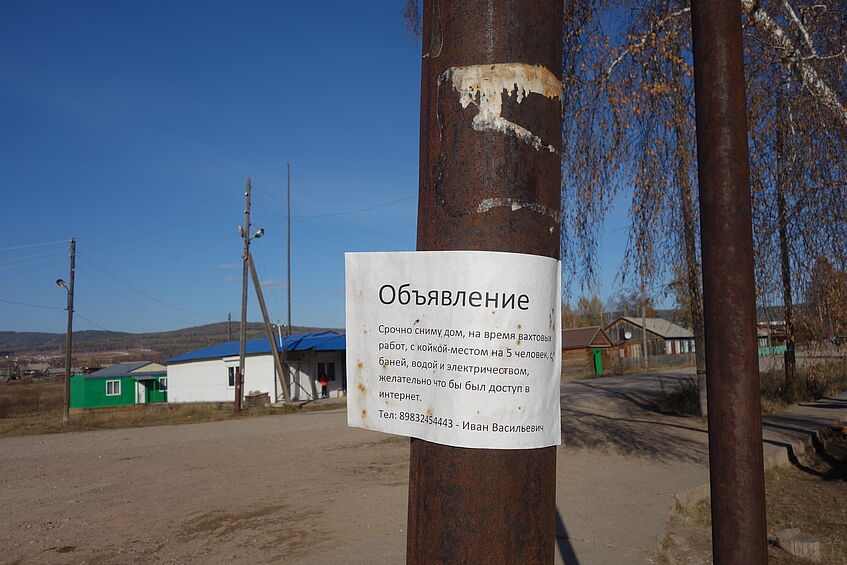
An anouncement for oil workers who wish to rent a flat for the time of their shift.
Approaching the 'heartland' of the BAM region, the next destination on the agenda was Verchnemarkovo - a village 'built on oil fields', stated by an informant in a mixture of pride and despair. Oil drillings commenced to be implemented already in the 1960's. Just like in other towns, having been built in the harsh climatic zones of the North, Verchnemarkovo experienced an enormous emigration movement when the command economy was terminated and when subsidies for local state enterprises were reduced or entirely stopped in the Post Soviet period. Currently, Verchnemarkovo has a population of 2300 people.
The village makes a rural appearance with mainly unpaved roads only used by a few cars. Verchnemarkovo can be referred to as a transport interchange for the oil business. Oil workers, often from distant regions of the former Soviet Union, are transported on special all-terrain trucks (vachtovka), to the small air ground located at the entrance of the village. From there they are distributed once more, mainly by helicopter, to the nearby oil fields.
Labour in the oil sector is organized according to the Fly-in/Fly-out model that preferably employs long distance commuters with specialized qualifications, often coming from traditional oil regions. While the local population, often lacking adequate skills, has difficulties getting an attractive job.
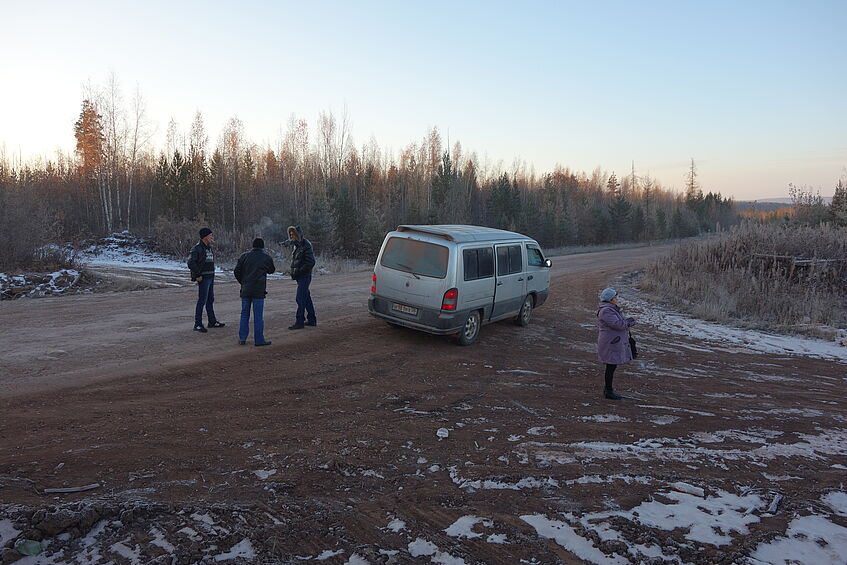
Short break for the passengers on the minibus to Ust'-Kut.
Another guiding research aspect was the role and social agency of the road that connects Verchnemarkovo and the regional centre Ust'-Kut, where one has access to the Baykal-Amur-Mainline (BAM), the on-spot airport and a new and increasingly popular regional bus network, providing trips to the capital Irkutsk.
Yet, being a regional transportation hub is not the main reason, why Ust'-Kut is of great importance to people living in Verkhnemarkovo. Ust'-Kut, as such, has a significant functional and symbolic meaning, since "for all elementary things people have to go to Ust'-Kut", as local informants tell. Thus, great attention is paid to the conditions and quality of the 150km gravelled road, which secures this connection and enables people to commute back and forth between their village and Ust'-Kut, the city of 50.000 inhabitants along the river Lena. Recent repair works improved the road quality significantly, reducing travel time from up to five and more - depending on seasonal and weather conditions - to three hours.
Currently, two private mini-bus companies offer each one trip per day to Ust'-Kut and provide a schedule that mostly meets passenger's matters of urgency, such as the Central Hospital's admission times. By having achieved modest wealth after working in the oil sector for years, quite a number of people in Verchnemarkovo are able to afford their own cars, consequently they are not depending on external transport providers. As shown by the preliminary analysis of questionnaires and qualitative interviews, people in Verchnemarkovo evaluate the present situation in terms of transportation opportunities and connectedness as more favourable than in the recent past, considering all the factors mentioned above.
BAM settlements Zvezdnyy and Niya
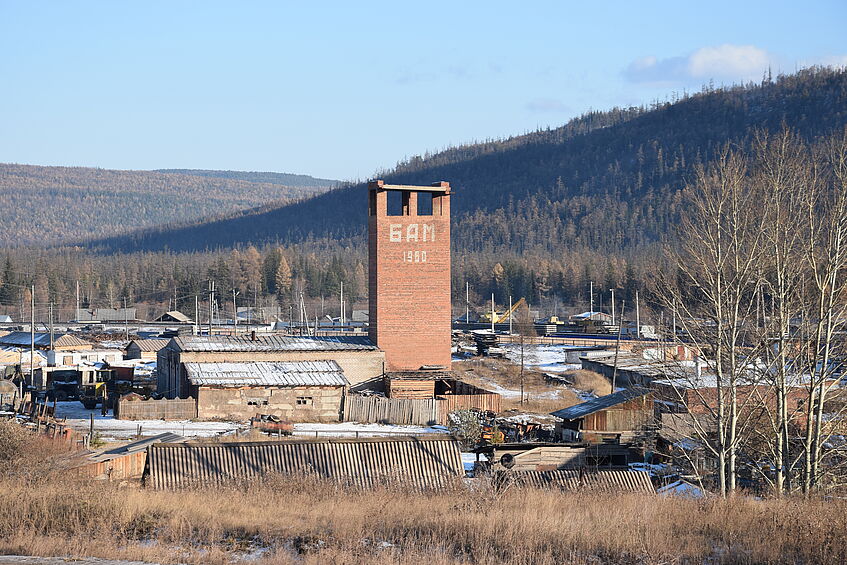
Strong symbolic presence of the BAM, but little practical significance for the local population.
Zvezdnyy and Niya are two of the so-called 'BAM villages' that were built in the 1970's parallel to and along the Baykal-Amur-Mainline. The railways and some logging companies provide the sources of income for the local population; quite a number of people also work as long distance commuters on northern oil fields.
On site we met BAM-builders, who moved there at an early age in order to not only build the tracks of the railway, but also communities and a home, under the extreme climate conditions of the North. During the interviews, their enthusiasm for the 'construction of the century' at the time seemed to remain unbroken. Currently, the second BAM track is being built. After years of stagnation and decline, official discourse promotes the extension and technical upgrading of the railway network as a new economic awakening. However, no enthusiasm for this project whatsoever could be detected when talking to the people who live next to this symbolically charged infrastructure. As reported by an informant, "we know that it is being build, but we don't feel it".
Presumably, one of the reasons for this lack of interest for the revitalizing of the greatest prestige project of the late Soviet Union might be that the local work force has not been involved in the construction process. Construction is being done by subcontracting companies that engage whole brigades of long-distance commuters mainly from Central Asia. It seems, that for the local population hardly anything has been changed related to the new BAM construction activities. People living along or on the BAM do not recognize sustainable developmental perspectives.
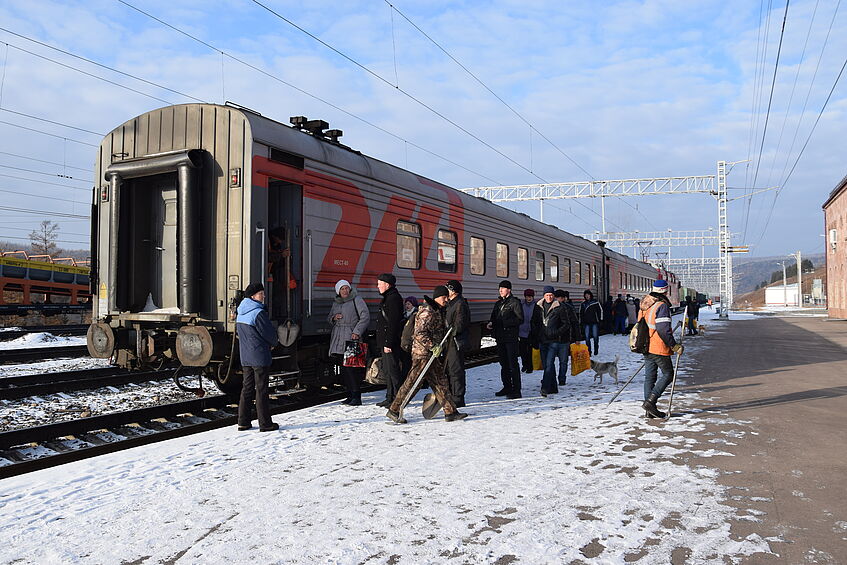
The 'Elektrichka' is the most important means of transport for the inhabitants of Zvezdny.
Prima facie, the 64 kilometres from Zvezdnyy and 100 kilometres from Niya to Ust'Kut do not seem to be too far of a geographical distance, but 'remoteness' is still an issue, also in the 'heartland' of the BAM region. The commuter train (elektrichka) for the railway workers constitutes the most important means of transport for the population of Zvezdnyy, Niya and several other BAM settlements. It is noteworthy that there is only one commuter train provided per day.
The travelling conditions on that commuter train are the source of complaints: there is only one, in summer two waggons, with 72 seats each, making it impossible for all passengers to fit in. Taking into account that only the most elementary things can be purchased in the village, that there is no doctor (only an ambulatory) and no bank or cash machine, explains the high level of dependence of the local population on the transportation network that connects them to the urban centre. Despite the poor road quality, significantly longer travel time as well as expenses for gasoline and frequent vehicle repairs, car owners still prefer to travel independently.
Unexpectedly, the long-distance trains are only of secondary significance for the villagers, who (partly) contributed to bringing the BAM into being and showing a high degree of personal commitment. An inconvenient schedule, i.e. trains passing the villages in the middle of the night, relatively high prices and a practically restricted access to tickets which can only be bought either at the train station in Ust'-Kut or via internet - under the condition that one has a functioning internet connection - makes the long-distance BAM-trains no real alternative to the commuter train.



